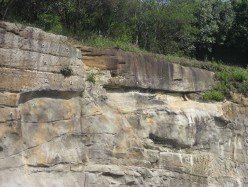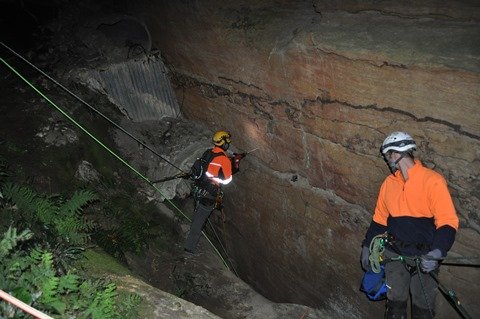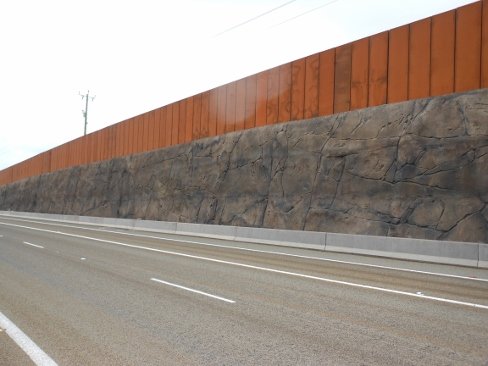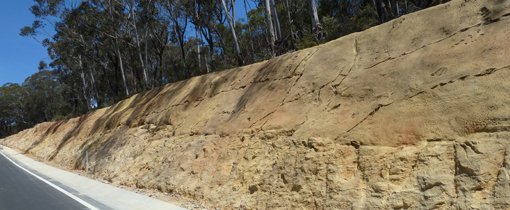
Simulated rock at the top of the cutting over natural rock – Blue Mountains, NSW. Photo: The Rix Group
By Matthew Hicks
Matthew Hicks has been in the Shotcrete and ground engineering business for the past twenty-five years. He has been an active Australian Shotcrete Society committee member for the last fifteen years. Matthew is a co-author of the AUSS Guide to Shotcreting in Australia. He is also the co-founder and Managing Director of The RIX Group, a highly reputable Australia wide specialist ground engineering company with particular expertise in all aspects of shotcreting. The RIX Group are the market leader in hand spraying and architecturally finished Shotcrete.
In this article, Matthew discusses the evolution of Shotcrete use and the essential considerations in thinking about a project with this type of Shotcrete application.
Dry Spray Shotcrete
Shotcrete first emerged in the late 20th century in America. The process started off using high-velocity air to blow the mortar, a mixture of sand and cement, through rubber hoses where water was introduced and mixed at the nozzle and named it Gunite.
Wet Spray Shotcrete
Around the 1960s a technique called wet spray came along. Water, cement, sand and aggregate were batched and mixed in agitator trucks. A traditional concrete pump was used to pump the wet shotcrete mix through larger hoses and compressed air was introduced at the nozzle. The process required a man holding a hose with a nozzle. It created larger volumes and much higher productivity.
Robotic Arm
Around the 1970s and early 1980s robotic equipment came into use. A robotic arm, rather than a human, would hold the hoses and direct the nozzle by remote control. This process was generally used to apply shotcrete overhead in mines and tunnels and also for high reach situations.
Australian Application of Shotcrete
In Australia, the first popular commercial use of shotcrete was in the construction of swimming pools. Up until then, pools required a lot of expensive formwork before the concrete could be placed. The new process would allow people to excavate the in-ground pool shape, install reinforcement, spray it with shotcrete, hand cut it to the shape of the pool including steps, edges and whatever else was needed. Now you could spray a pool in a day, whereas with traditional build involving formwork might take a week.
Cost Effective Shaping
You could also get various shapes out shotcrete by cutting it freehand. To achieve those same shapes using formwork remains extremely expensive. The new shotcrete process proved itself to be very versatile, quick, and therefore economic.
Strength In The Mix
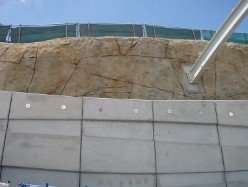
Simulated rock dry spray at the northern entrance to the Clem Jones Tunnel, Brisbane. Photo: The Rix Group
The reason shotcrete can stand up on its own is because of the use of a lot of cement. Hand-applied wet shotcrete is a very sticky mix with low slump, small aggregates, graded sands and certain mix designs. These include additives which help it stand up and hold in place when you spray it up vertically. It allows you to cut and shape alongside appropriate reinforcement.
Shotcrete In Mining
Shotcrete is used for ground support in mines and tunnels. This means that when you excavate a big hole in the ground and you want to support the roof, you can spray shotcrete alongside steel reinforcement, mesh. Alternatively you can add either steel or plastic fibres into mix to limit or negate the use of the traditional reinforcement. Shotcrete acts as an effective ground support. It’s very quick, and it’s used all over the world. It’s become huge in that market over the past twenty or thirty years.
Road & Cliff Stabilisation
The RIX Group are active in the architectural use of shotcrete. For example, we spray shotcrete by hand on roads or cliffs that require stabilisation. We can follow the contours of that cliff and it’s very effective. You can’t pour concrete on to these surfaces because you need formwork. That would be hugely expensive, and impossible in general circumstances from an economic point of view.
Shotcrete Finish
The basic finish of shotcrete application is an off the gun finish, a nozzle finish. This is rough and pitted where you can see and feel the aggregates, the stone in the mix, sticking out. Our Artisans can then start screeding and floating it to a given line, to give a render like finish. We can put joints in it to simulate pre- cast panels concrete and so forth. Our specialist teams can deliver what’s called simulated rock, or blocks, or mock rock. In many zoos around the world, they have created enclosures which depict the animal’s home environments. Many have been treated with hand-sprayed shotcrete to create a natural look.
Taronga Park Zoo
For example, in Sydney’s Taronga Park Zoo they have a beautiful Southern Oceans enclosure housing the penguins, seals and sea lions. This exhibit contains a lot of shotcrete in the rock work. Rather than just leaving the structural bare concrete walls, we spray our product over them, then carve and cut joints to simulate sandstone or certain kinds of granite or rock. We can add oxide in the shotcrete for a base colour, and then we can apply paints and an oxide at the end. This finishing process is called staining.
The Peak in Hong Kong
We can offer these finishes for various project like that on a cliff face or in a theme park to simulate natural surfaces. You’ll see shotcrete used at the Peak in Hong Kong. You walk around the peak right at the top and see rock bolting and shotcrete has been used to stabilize and hold it all together. It’s hard for the untrained eye to notice because a lot of vegetation growing over it nestling in with the natural environment.
Shotcrete Project Assessment
There are a number of factors to consider when assessing whether a project is suitable for this style of shotcrete application.
Access
The first thing is always access. Can we get in there to do the job?
Height
The height of the project is also important. For example, if a client want a high-end finish you generally need the crews to be in a standing position. Ideally, you need the working height to be at least the team workers standing height. But if the project requires greater heights then you can work from various types of access equipment but this reduces production and in some instances, it’s very challenging.
Set Up
Preparation is everything. Reinforcement for a project has to be fixed correctly to a given line and installed by experienced crews who have knowledge of the shotcrete process. This is essential because if you just throw the reinforcement up without due care then try to spray the shotcrete, the whole lot can end up on the ground. This is no different to general building situations. If you want to paint a window, you have to prepare the timber, fill any holes, you’ve got to rub it down, make sure there’s no dust, and then you apply the paint carefully. In shotcrete projects you must fix the reinforcement in a certain way to ensure that the artisans of shotcrete are able to get a good finish. Poor preparation can cause shotcrete to peel, slough or fall or collapse and then the day can go very pear-shaped and no one is happy.
Mix Design
To deliver a great project we require a good shotcrete mix. Suppliers can give you very good or bad shotcrete mix. You need very good technical department support from your supplier. You need to discuss with them what you’re trying to do. We call this “mix designs.” You need to make sure the mix design is suitable for your application.
Correct Equipment & People
The correct equipment and skilled teams are paramount to any projects success. Shotcreting is no different but it is not normal everyday concrete so your team to have to have specific knowledge and understanding of shotcrete and the way it behaves. It’s not easy. It’s challenging. You need to have an artistic eye as well as a capacity for physical endurance. You can’t just employ a concreter and assume he’s going to have the skills for this type of application.
Physical Work
Spraying shotcrete by hand is not easy and more challenging when you are trying to accomplish a visual affect. You have to set up reinforcement with screed lines then spray with accuracy. You then need to screed to the line, cut it, and put your joints in. It’s hard because it’s very sticky, whereas normal concrete on the floor is easier to screed and finish. This is very different. It’s a lot thicker and it’s more challenging to deal with.
Excavation
You should be very careful when you’re excavating for a shotcrete wall. It’s easy to deploy big machines that work faster, rush it and over-excavate beyond the design thickness so the walls become very thick. You then have to fill these areas up with shotcrete which wastes a lot of time and money and it can cause a lot of problems. We strongly recommend you take extra time at the start of any project and plan carefully with the teams involved.
Get Rid of Water
You should avoid situations where there’s water coming out of the substrate. Shotcrete doesn’t behave well with water. You’ve got to make sure you deal with that water beforehand. Basically that would involve covering the water with something to create a new substrate to spray upon. This is important because it’s very difficult to stop water pressure affecting the shotcrete, it causes it to peel off and fall out.
Avoid Long Distance Pumping of Shotcrete
You should avoid very long pumping instances with shotcrete, unless you have special equipment and special mixes. This is important because it can get blocked in the shotcrete delivery lines and, once it gets blocked things can go south very quickly.
Be Realistic
You should avoid anything that’s unrealistic. Shotcrete has its limitations just like any product. Avoid trying to get something from it that it’s not designed to do.
Choosing Skilled Personnel
A shotcrete sprayer who works in a mine or tunnel generally operates a tele-remote robotic shotcrete rig. They can train on a simulator and operate from a joystick. If they pass, they will get a certificate to say that they have the appropriate level of skill for the task. This can be effective for tele remote application because there are very good simulators these days. You can’t apply that that style of training for hand-spraying, because you can’t do it with a simulation.
You need someone who’s fit, has very good balance, and a good eye. The only way they can learn it is on the job next to someone who has a lot of experience. You can’t learn it from a screen. You can’t learn it on a simulator. You have to physically do it.
People involved in the architectural application of shotcrete also have to have a passion for what they do because it involves care and good judgement. If you spray too much shotcrete the surface you are working on it will peel and fall down.
Take Time To Access Expertise
The process and end product of shotcrete application is just like any other part of the construction industry. You get what you pay for. If you are engaging someone on a shotcrete project take extra time and investigate whether they have experience in this area. Have a look at what they’ve done before. Ask questions about the individuals who are actually going to apply and finish the shotcrete.
Little Australian Regulation
There aren’t any standards for shotcrete in Australia or specific accreditations. They have them in Europe and America. In Europe they generally apply to tunnel construction. In America, they also include hand-spraying accreditations. Australia has no formal accreditation process and for this reason it can be a bit of a Wild West. This is why you need to do your homework. You need to check on the experience of companies and their teams you are engaging.
Australian Shotcrete Society
Along with my colleagues at The Australian Shotcrete Society including expert advice from my colleagues at The RIX Group we have published a guide for shotcrete in Australia. If you would like to know more you can visit the website and get a copy of the guide. It is extremely relevant to shotcrete in Australia and has been internationally applauded. There are various high level specifications published by RMS in New South Wales. Queensland Main Roads, have a specification as do Vic Roads in Victoria. They’re fairly in- depth and quite technical but they are generally limited on shotcrete finishes and some of the other things I’ve been talking about. If you want to know more about shotcreting I recommend you have a look at a guide called, Recommended Practice – Shotcreting in Australia from the Australian Shotcrete Society. It’s easy to follow and full of practical information.
Future Trends – Stabilisation
In future, I think more clients will be using shotcrete as a final finish. Certainly, we find that the more people who find out about our simulated rock work, the more they want to use it. We’re doing a lot of work around Sydney Harbour at the moment, where the old sandstone blocks are failing. The logistics and price to replace them is uneconomical and coupled with the physical time to undertake the work, due to tidal movements, these are the big challenges. We can go in there and fix our mesh, spray and sculpt our shotcrete during the low tides and get a very swift and similar effect. We’re doing that a lot more, and our clients are very happy and impressed.
Shotcrete is also being used more in civil excavations and infrastructure projects as a stabilisation method. It should always be used in the context of what it is. Like any concrete, you shouldn’t overdo it. That’s why the simulated rock or block work can be very effective. If you apply it in certain areas, on a road embankment for example, where there is stable, solid rock surrounded by poor ground, you can spray around the rock then sculpt and colour to the poor ground to blend in. I see this type of application increasing in popularity especially when architects, builders and the general public see more examples of where it has been done well and it looks great.
Read more:

